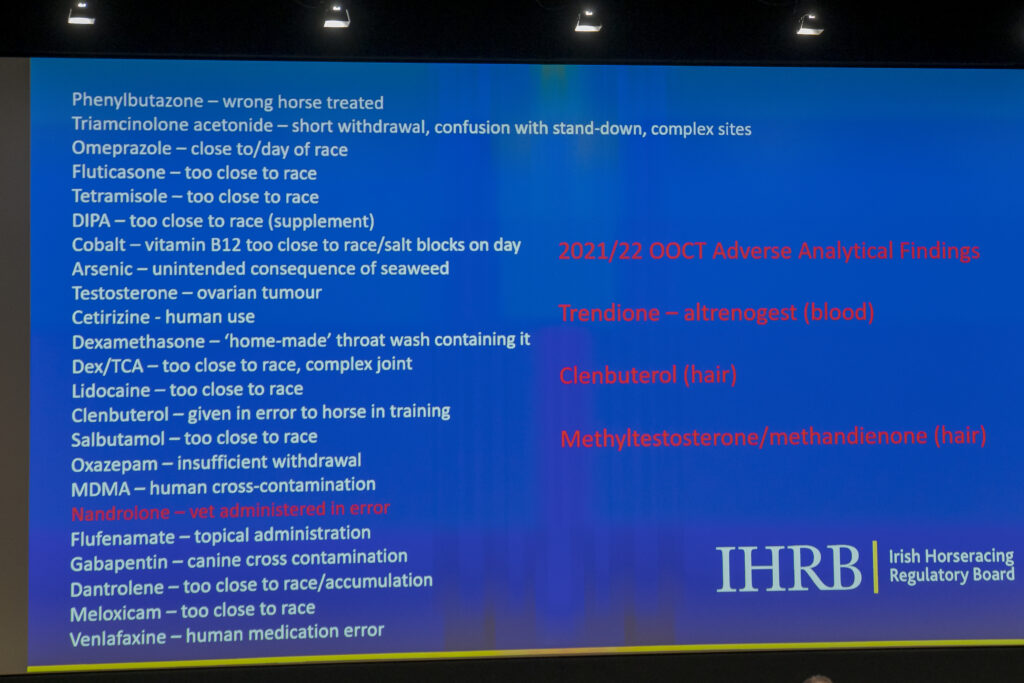Session 3: FEI Equine Anti Doping and Medication Control Regulations
Monday, 29 April, 15:30 – 17:30
The third session of day one at the FEI Sports Forum was formed around a discussion on Equine Anti-Doping and Controlled Medication Regulations (EADCMR), the only FEI rules that are undergoing a full revision this year. The session shed light on crucial aspects of maintaining integrity and fairness throughout FEI disciplines, and horse sport in general taking in experience from the racing industry and building further on the action points from the “Good life for Horses” plan. The panelists delved into various key topics essential for athletes, trainers, and stakeholders to understand and adhere to.
After a short recap of the 2020 FEI Sports Forum and the full rules revision of that year, the session kicked off with the topic of out-of-competition testing, emphasizing the need for continuous monitoring to ensure a level playing field for all competitors.
During the discussion, the essential legal question was posed by FEI Legal Director Mikael Rentsch, who is the person responsible for the horse when it comes to testing for controlled medication and/or doping? In endurance it is the trainer, in other disciplines, it is not so straight-forward. As part of the action tasks, FEI wants to go into out-of-competition testing to ensure horse welfare in a broader sense, safeguarding the horse even out of the competition environment. The question was posed to the audience as to who remains responsible for out-of-competition testing – trainer, owner, or athlete as in rider or driver?
The only true conclusion was that the grooms are not to be responsible as it would be too tempting to pin that responsibility on the weakest party. The International Jumping Owners Club explained in detail how owners not even are on the same continent as their horse and cannot be responsible. The International Jumping Riders Club declared similar views as many riders are temporarily riding horses for owners. As of now, endurance is the only discipline with a registered trainer, that might change in the future. In essence, no one jumps up to be the responsible person for a horse – a bit strange, after all, we are their human guardians.

Lynn Hillyer, Chief Veterinary Officer & Head of Anti-Doping with the Irish Horseracing Regulatory Board (IHRB), explained the timeline and progression of the IHRB’s equine anti-doping and medication control protocols since the body’s inception in 2018, showing an impressive increase in sampling rates, strengthened further by a digitization process necessitated by the Covid 19 pandemic.
IHRB collects out-of-competition samples where specifically the hair samples provide information from months back. They only look for prohibited substances but can detect controlled medication which should be visible in a horse’s logbook for follow-up. They also look for stables and yards with HSR High Strike Rates and exceptionally high performance that can indicate unfair proceedings, through medication or doping.

Although the auditorium was very aware of the costs involved with an out-of-competition testing program, even FEI president Ingemar de Vos weighed in and pointed to NFs for this cost coverage. In the auditorium, there was an uneven welcome to the future procedures with out-of-competition testing although clearly stated as point to strengthen horse welfare in Equine Ethics and Wellbeing Commission final report and proposed action plan where it one of the 60+ actions tasks. .
Göran Åkerström, FEI veterinary director, stated:
“Testing out of competition will be a big deterrent for people and it is not more expensive than competition testing in itself, we can do it through the current base of laboratories and technicians.”
“But if you look at the costs, we’ve done benchmarks, we’ve checked with Lynn Hillier, I’ve checked with French Trotting and Racing and Swedish Trotting and the cost for out-of-competition testing is more than less equal to that of in-competition testing. But you need to plan it carefully .”

Swedish veterinary delegate Peter Kallings welcomed an additional testing protocol.
“This is really good work, we are ready to start in Sweden. We’ve been waiting several years for this. The Swedish Equestrian Federation has access to staff working mainly in trotting and racing, they’re used to this and FEI testing technicians and the lab has also been on this track for many years back so we’re just waiting for the legal proposal regarding the person responsible. someone suggested previously that it might well be the horse itself instead that receives the sanctions.
However in my line of work, I have often found the logbook to be empty for the horses, it would be better to use the FEI Horse App for this.”

Mikael Rentsch weighed in with:
“I agree that currently, we do have the medication logbook that many athletes are not using and filling in the information. I think we need to push on that and be stricter, probably have an associated sanction not linked to just out-of-competition testing.”
Jessica Kürten suggested that there perhaps is no need for a person responsible if the horse itself is sanctioned and prohibited from competition for a designated time depending on what substances would be discovered in testing. Many agreed that it could be a viable approach.
Gene Doping – new threat

The topic of gene doping was also addressed, underscoring the ongoing efforts to stay ahead of emerging technologies and practices that could compromise the integrity of equestrian sport. FEI Senior Veterinary Advisor Caterina Termine used simple and engaging analogies to explain gene doping, as well as highlighting the dangers of the former over the latter. Potential effects are for example when gene doping is directed towards the brain cells it is possible to increase the horse pain threshold. When directed at the Bone Marrow, the increase of red blood cells enhances stamina.

Caterina Termine also presented FEI proposals for new rules to be implemented, such as including provisions around gene doping within the current EADCMRs.

She stated:
“We have to tread carefully. Some of the scientific reports are quite alarming. They have linked gene doping to deaths and there’s been a lot of safety concerns for patients. And I’m sure the animals have undergone gene doping. So that’s a big red flag for us to be aware of. The next thing is that gene doping isn’t ethical. It can result in an unlevel playing field. It can negatively impact the public acceptance of our sports. And finally, we have to look at the scientific advances. Science moves very quickly. There’s a lot of research into this area.
We don’t want to prohibit something that could be therapeutic to the horse. We need to list the permitted practices and an example of that is the use of mRNA vaccines that we’ve recently seen during the COVID pandemic. And since the use of those vaccines, research has started to look to see if mRNA vaccines could be used in horses.
We wouldn’t want to prohibit anything therapeutic for horses. Hence we do need to be careful when we draft the rules. We of course want to implement the best practices. That’s very important to us.”
Hair raising new possibilities – not spot on, spit in
In the area of testing for prohibited substances, FEI Veterinary Director Göran Åkerström led a discussion that proposed the implementation of testing hair and fluid (saliva) samples as effective and non-invasive methods. This could mean an improved testing protocol that could prolong the detection window for several months.
Göran Åkerström was enthusiastic over the possibilities with hair and saliva used for testing:
“Why should we introduce hair as a testing matrix? Well, right now we have blood and we have urine and that just gives a snapshot in time of what is found in the horse. The beauty with hair testing is that if I pull this one out here on my own head it actually could be seen if I have been medicating corticosteroids for example or almost any medication, it will be stored in the hair. You can detect it inside the hair. It’s the same thing with the horse’s hair. It prolongs the detection window by several months. And this is already a very well-established method within horse racing. It’s been around for more than 10 years, in Swedish trotting for 15 years.”
“If we look at saliva then the problem that we currently are facing is that if you microdose quickly eliminated drugs for example beta blockers that would lower the heart rate on the horse and you do that in endurance [ed. note the foul-playing people that is]. We will not detect that when we do the post-competition testing because by then it’s already out of the system. The concentration will be so low that we cannot detect it. So therefore, we would like to collect saliva because we want to avoid invasive methods, we don’t want to put a needle in a horse during competition if we can avoid it. “
To set the scene for illustration purposes. At a vet gate during an endurance competition there is a slim chance of collecting urine and blood samples is avoided while the competition is ongoing. Saliva could be collected and detect the substance as well as be harvested without invasive action.
There is a lower reporting level for cocktail administration and that causes the problem. Substances with the same/similar/synergetic or masking effect are each administered in a lower dose to avoid exceeding the reporting level.
In conjunction with this, the issue of ‘cocktail administration’ of controlled substances was raised, highlighting how adding multiple controlled medications together can effectively ‘cheat’ positive testing levels by providing a performance-enhancing effect to a horse without exceeding the reporting level which would result in the sample testing positive. In order to counter this, the FEI is proposing to reduce the reporting level in multiple substance cases by 50%
Some doping offenses are worse than others as Göran Åkerström stated:
“A horse will “benefit” for years from anabolic steroids and would probably need to be suspended for years”

Link to presentation from session 3
Link to biographies of panelists
